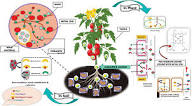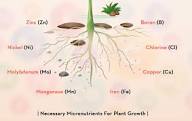Zinc, copper, chlorine, and sodium are micronutrients because they are needed by plants in minute quantities. However, their deficiency in the soil and plant systems affects the productivity of crops. In this article, readers will learn about the factors that affect the ability of the soil to supply zinc, copper, chlorine, and sodium.
Read Also: Pig Breeds: Origin, Indigenous and Exotic Breeds of Pigs
Zinc Dynamics in Soil and Plant Nutrition

1. Zinc Sources and Functions in Crop Growth
The element occurs in nature as ZnS, and it is absorbed by plants as Zn²⁺. Zinc has a very great tendency to form stable complexes.
It is a metal activator of enzymes, vital for carbohydrate transportation from roots to other parts, and aids in the formation of auxins (plant growth hormones). Zinc promotes the absorption of water by plants.
- Soil pH: Zinc is more available at low pH and vice versa.
- Phosphorus-zinc antagonism: High phosphorus content may induce zinc deficiency.
- Organic matter: Zinc is part of organic matter and is chelated by organic matter. In organic soils, where organic matter is excessive, the chelation may be to the extent of making zinc unavailable.
Read Also: How to Increase Egg Production in Commercial Layers
Copper Dynamics in Soil and Plant Nutrition

2. Factors Influencing Zinc Availability in Soils
1. Copper Sources and Functions in Crop Health
Copper is absorbed by plants as Cu²⁺. Ninety-nine percent of the earth’s crust has copper in impure form, in the form of sulfides and oxides, e.g., chalcocite (Cu₂S), copper pyrite (CuFeS₂), etc.
Copper serves as fungicides or germicides because it is toxic to lower forms of life. Copper helps as an activator in enzyme systems, and its deficiency is common in organic soils.
It is a precursor of chlorophyll but not part of the chlorophyll molecule. Copper inactivates certain toxins produced by certain fungi and bacteria. Copper is also associated with nitrogen fixation and mineralization.
2. Factors Influencing Copper Availability in Soils
- Soil pH: Copper availability increases with a decrease in pH.
- Organic matter: Organic adsorption ties up a lot of copper. In many cases, they are soluble; however, copper deficiency may still occur in organic soils because of fixation and chelation.
- Nutrient interaction.
Chlorine and Sodium in Soil and Plant Nutrition
1. Roles and Impacts of Chlorine and Sodium in Crops
Chlorine is recently found to be essential and is required in very small quantities. The problem is usually with its excess rather than its deficiency. It is usually in the form of CaCl₂ and MgCl₂.
Excess chlorine affects the quality of some crops, e.g., tobacco leaves, and the storage quality of potatoes and yams. Sodium is recently found essential for plants like tomatoes.
There are many factors that affect the availability of soil nutrients. Hence, plant growth is not only determined by the abundance of soil nutrients but also by the factors that enhance or militate against their uptake.

